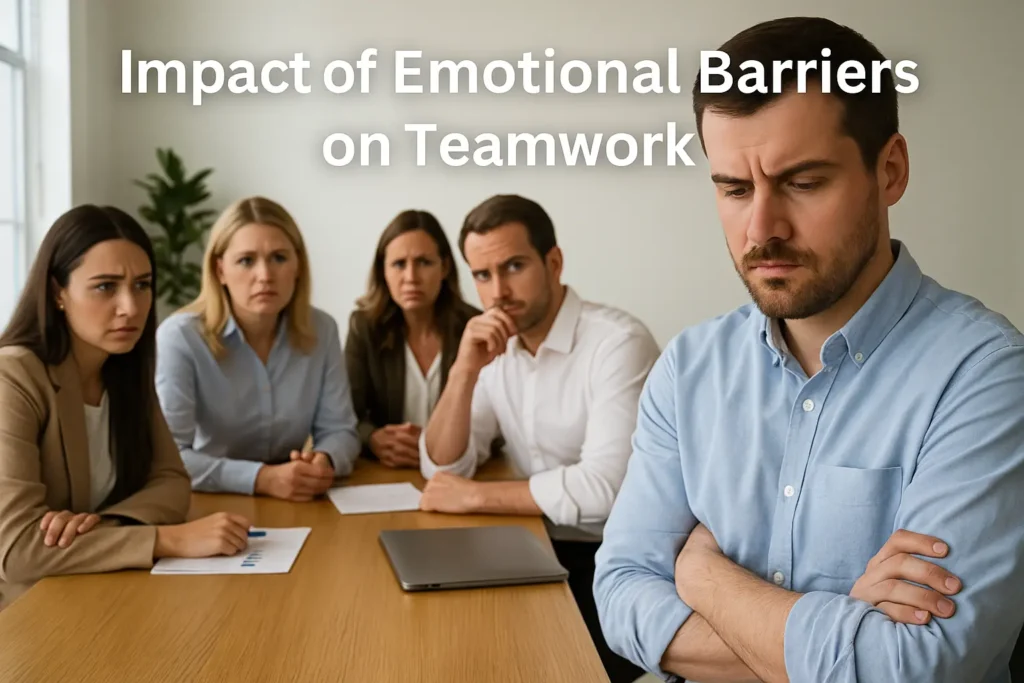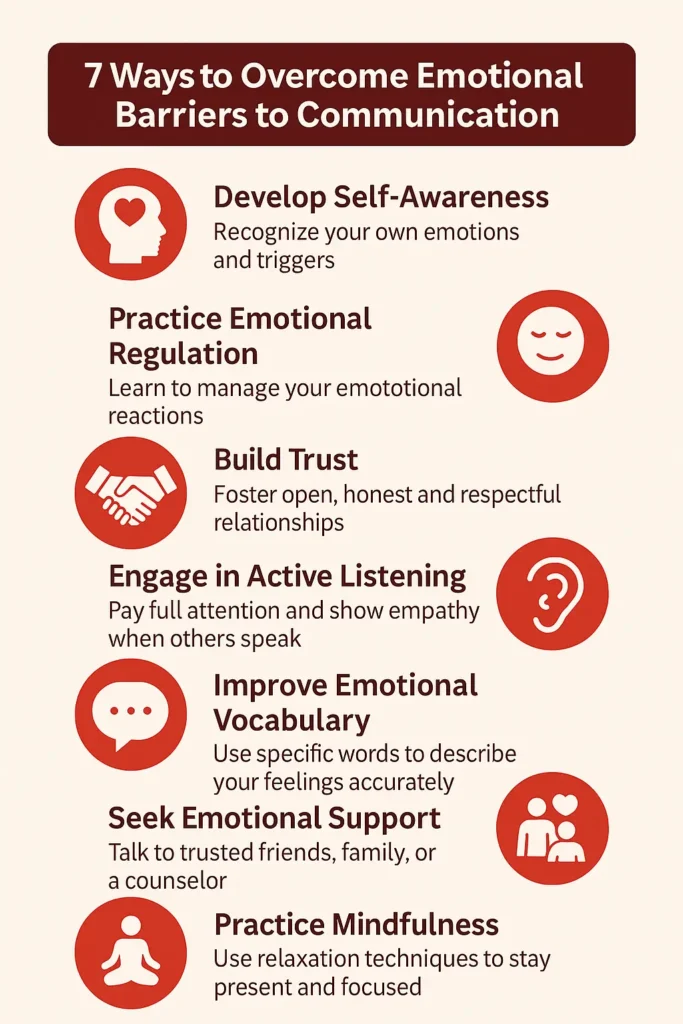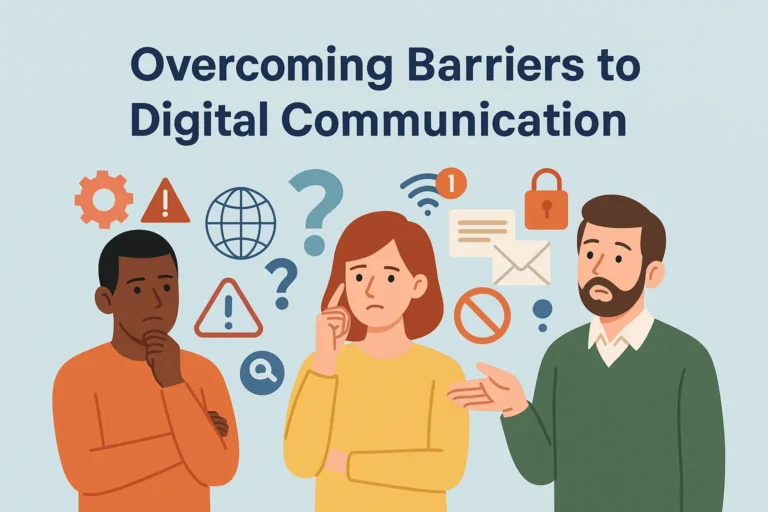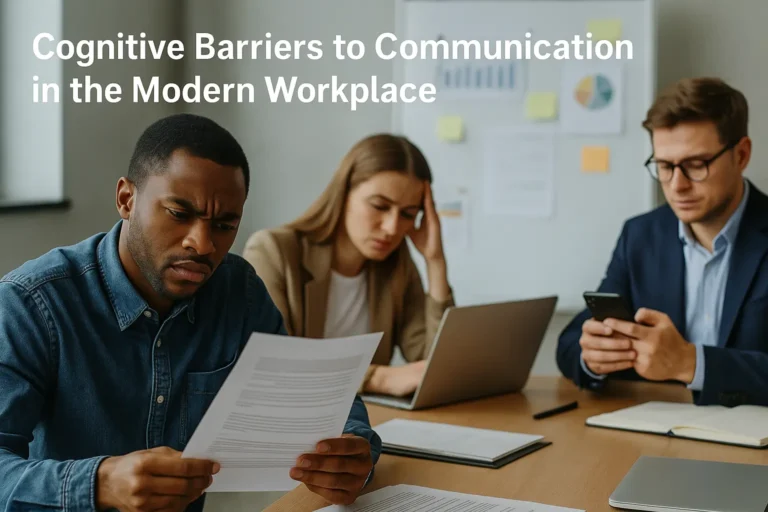Emotional Barriers to Communication (7 Proven Strategies)
Have you ever wondered why a conversation goes wrong—even when you use clear words and a positive tone? Many times, the reason is emotional barriers to communication. These obstacles are often invisible, but they can disrupt the flow of information and block better communication in the workplace and beyond. If you want to overcome emotional barriers to communication, it’s essential to recognize what they are, how they work, and the strategies that truly help.
What Are Emotional Barriers to Communication?
Emotional barriers in communication are mental and emotional states that limit our ability to communicate effectively. These barriers often act as invisible walls, quietly impacting conversations at work, in education, and even among friends or family. A particular emotional barrier is a mental block—a feeling or thought that stops someone from sharing openly or listening to others.

Sometimes, an emotional barrier is obvious, like visible anger or panic. Other times, it shows up as silence, withdrawal, or a lack of emotional support. The presence of emotional barriers can prevent honest conversation and trigger miscommunication. Common emotional barriers include anxiety, insecurity, pride, and negative affectivity. Each of these can create a unique obstacle, changing the way information is sent, received, and understood.
Emotional barriers often interact with other obstacles to effective communication. For instance, cultural differences may trigger emotional responses like fear or discomfort, making communication even more challenging.
Common Types of Emotional Barriers to Communication
Let’s look at common emotional barriers that show up in workplaces, classrooms, and everyday conversations.
Fear and Anxiety
Fear is a powerful emotion that can instantly hinder effective communication. People often fear judgment, rejection, or failure, leading them to remain silent or guarded. Anxiety—whether it’s social anxiety or panic—triggers avoidance and can make even skilled communicators hesitate. These emotional states often lead to misunderstandings, as people filter what they say and how they listen.
Insecurity and Low Self-Esteem
Emotional insecurities and low confidence can prevent someone from speaking up or sharing their honest thoughts and feelings. This barrier may arise from past criticism, a strict workplace environment, or a lack of emotional support. People who feel insecure often hold back their ideas, limiting effective collaboration and the development of new relationships.
Anger and Negative Affectivity
Anger is another major trigger for communication breakdown. It causes defensiveness and may turn a calm discussion into an argument. Negative affectivity—a tendency to experience negative emotions—affects the ability to communicate in a healthy and effective way. It can also lead to overreaction, defensiveness, or complete withdrawal from conversation.
Pride and Ego
Pride sometimes acts as a barrier, making people unwilling to admit mistakes or listen to feedback. When pride gets in the way, even constructive criticism feels like a threat, leading to more emotional roadblocks and limiting open communication.
Stress and Mental State
Stress (biology) has a direct impact on the emotional state and mental health of individuals, often affecting the ability to communicate and process information clearly. In high-pressure environments, people may struggle with emotional regulation and find it hard to listen to others, leading to frequent misunderstandings.
Emotional Triggers
A trigger is any word, gesture, or cue that stirs up a strong emotional response. These triggers may be linked to psychological trauma, mental disorder, or negative past experiences. Triggers can quickly escalate a conversation or shut it down entirely, limiting effective communication.
Workplace Communication and Emotional Obstacles
Communication in the workplace is crucial for team productivity, healthy culture, and professional growth. Yet, communication barriers in the workplace—especially emotional ones—can block the flow of information, slow projects, and even damage employee morale.
Impact of Emotional Barriers

- Reduced trust: Emotional barriers often prevent transparent communication, which can undermine trust among team members.
- Decreased collaboration: If people don’t feel safe sharing their thoughts and feelings, it’s hard to work together effectively.
- Lower engagement: Emotional barriers can lead to apathy, withdrawal, and a lack of participation in meetings or team activities.
- Higher turnover: Employees who constantly face emotional barriers are more likely to leave, affecting the organization’s stability.
Types of Communication Affected
Emotional barriers can influence all types of communication—from verbal communication in meetings to written emails and even nonverbal cues like body language. Misreading someone’s tone or gesture can lead to misunderstandings and escalate minor issues into conflicts.
Examples of Emotional Barriers in the Workplace
- A manager’s harsh feedback triggers an employee’s anxiety, making them shut down.
- Team members from different backgrounds misunderstand each other’s communication styles due to cultural or language barriers.
- A new employee feels insecure, afraid to share ideas during brainstorming sessions, resulting in missed opportunities for better communication.
Emotional Barriers Across Different Communication Situations
Barriers in Cross-Cultural Communication
Cultural barriers are often linked with emotional ones. Cultural differences in communication styles can create perceptual barriers and emotional triggers. For example, in some cultures, direct criticism is common, while in others, it’s seen as offensive. These differences can quickly cause discomfort and miscommunication.
Gender Barriers and Emotional Communication
Gender barriers also play a role in creating emotional obstacles. Stereotypes about how men and women “should” communicate may affect the way people express or interpret emotions. For instance, a man might be hesitant to show vulnerability, while a woman might fear being labeled as “too emotional.” These attitudes may lead to emotional disconnect and misunderstandings.
Barriers in Digital and Remote Communication
Remote work and digital tools change the landscape of communication. The absence of nonverbal communication cues—like facial expressions or tone—makes it easy to misread messages. In virtual meetings, emotional barriers are harder to spot, and misunderstandings can snowball quickly.
How Emotional Barriers Create Obstacles to Effective Communication
Common Signs and Symptoms of Emotional Barriers
Recognizing emotional barriers is the first step toward overcoming them. Here are signs that emotional roadblocks may be present:
- People avoid certain topics or become defensive during conversations.
- Important feedback is not given or received well.
- Employees show signs of stress, anxiety, or withdrawal.
- Conversations often end in conflict or misunderstanding.
- There’s a lack of emotional awareness or control in meetings.
How Barriers Affect Communication Patterns
Emotional barriers affect communication patterns by creating distance, mistrust, and confusion. They can:
- Block open conversation and limit the sharing of new ideas.
- Disrupt the natural flow of information in teams.
- Prevent people from paying attention to others or listening actively.
- Cause misinformation to spread, especially when people fill in communication gaps with their own assumptions.
Why Emotional Barriers Lead to Misunderstandings
The Role of Perception and Cognition
People interpret words, gestures, and tone based on their own perceptions and mental state. Cognitive bias and confirmation bias can distort what’s heard or said, especially if someone is already in a negative mood.
Emotional Triggers and Negative Responses
Certain words, topics, or behaviors act as emotional triggers. When triggered, the emotional response can be strong—leading to defensive behavior, outbursts, or silence. This is a classic way emotional barriers lead to misunderstandings and prevent healthy communication.
Strategies to Overcome Emotional Barriers to Communication
So, what can you do to overcome emotional barriers to communication and support better relationships at work and beyond? Here are some proven strategies:

Build Self-Awareness and Emotional Intelligence
Self-awareness is the foundation of emotional intelligence. Being mindful of your own feelings, triggers, and communication style helps you manage reactions and adjust your approach. Emotional intelligence also means recognizing emotional cues in others and responding with empathy.
- Practice mindfulness or meditation to become more aware of your emotional state.
- Regularly check in with yourself about stress, mood, and energy.
- Seek feedback from trusted colleagues or friends about your communication patterns.
Practice Active Listening
Listening is more than just hearing words. Active listening involves paying attention to verbal and nonverbal cues, asking clarifying questions, and summarizing what you’ve heard. This reduces miscommunication and helps build trust.
- Use relaxation techniques to stay calm during challenging communication.
- Show empathy through your responses and body language.
- Pause before responding, especially if you feel a strong emotional trigger.
Encourage Open and Transparent Communication
A culture of open communication helps break down emotional barriers. People feel safer expressing themselves when they know their ideas are valued and mistakes are seen as learning opportunities.
- Managers should model transparent communication, share their own experiences, and admit when they don’t know something.
- Teams can use regular feedback sessions or mentorship programs to foster trust and understanding.
Provide Emotional Support and Resources
Organizations should offer resources for emotional well-being, such as:
- Access to counseling or therapy services
- Mental health workshops
- Peer support groups
- Critical thinking and stress management training
Providing emotional support is not just about reacting to crises; it’s about building psychological resilience and well-being for everyone.
Expand Your Emotional Vocabulary
Use clear, specific words to express your feelings accurately instead of vague statements or silence. When you’re upset, say “I feel disappointed about the project delay” instead of just saying “I’m fine.” Being precise helps others understand your true feelings and respond more appropriately.
Seek Emotional Support
Reach out to friends, mentors, or professionals when feeling overwhelmed, stressed, or uncertain. Talking about your feelings can provide comfort, perspective, and helpful advice. You don’t have to handle emotional challenges alone—support makes communication easier.
Practice Mindfulness
Use relaxation techniques or meditation to stay present, focused, and less reactive during emotional moments. Taking slow, deep breaths or focusing on the current moment can prevent emotions from taking over. Regular mindfulness practice helps you manage stress and communicate calmly, even in difficult situations.
Overcoming Barriers Requires Effort and Practice
Consistent Strategies to Overcome Emotional Barriers
Breaking down emotional barriers is not a one-time fix. It requires ongoing effort, education, and self-reflection.
- Use communication skills training and personal development exercises.
- Foster a mindset that values growth, feedback, and constructive criticism.
- Address physical and language barriers, too, since these often interact with emotional ones.
The Importance of Psychological Safety
Teams thrive when members feel safe to express ideas, admit mistakes, and ask questions without fear. Psychological safety is essential for effective collaboration and the reduction of emotional barriers. Leaders should encourage healthy and effective conversation, celebrate diversity, and address signs of psychological trauma or mental health issues proactively.
Conclusion
Emotional barriers to communication can appear anywhere: at work, in education, with friends, or within families. They are one of the most common obstacles to effective communication, and if left unaddressed, they limit progress, trust, and growth. Understanding the impact of emotional barriers to communication—and taking steps to overcome them—is essential for anyone who wants to build better relationships, improve workplace communication, and create healthier, more productive environments.
The key to overcoming emotional barriers to communication is self-awareness, emotional regulation, and a commitment to open, honest conversations. Start by identifying your own emotional barriers, and encourage your organization or team to do the same. Practice these strategies every day to improve communication in the workplace and beyond.




